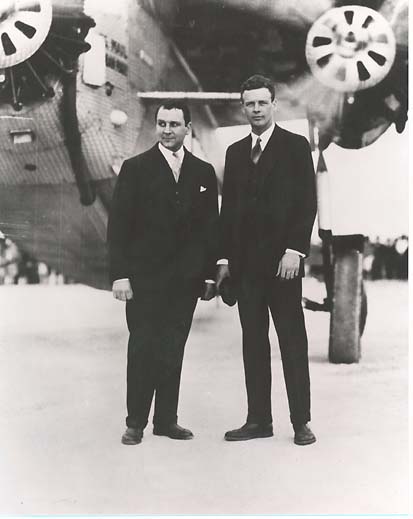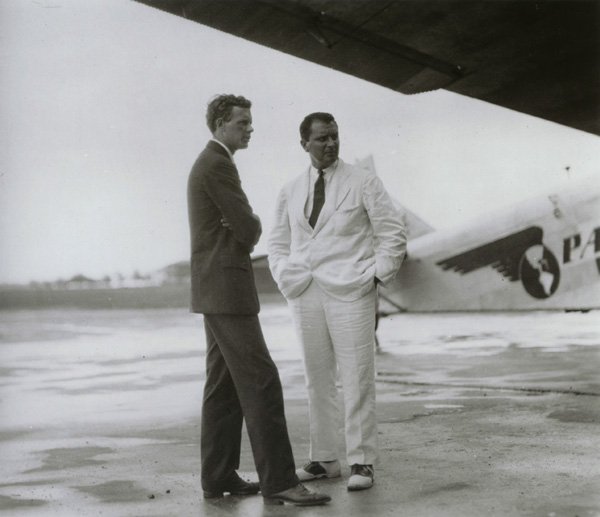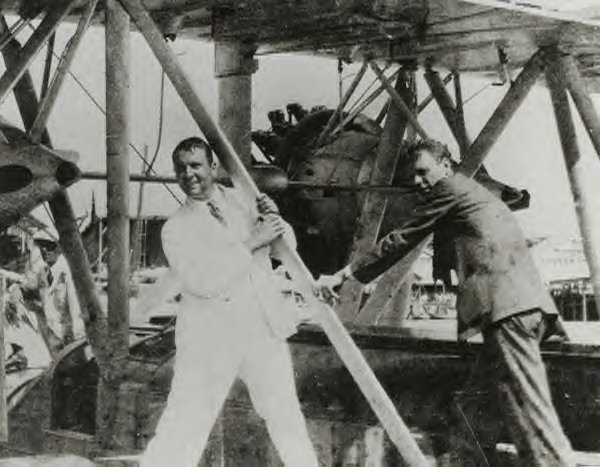
by Richard Branson
A Letter From Lindbergh To Trippe: September 15, 1933, Handwritten Report

"In establishing a transatlantic air route it is fully as important to decide which route will be most advantageous in the future as it is to decide which is the best to operate over today... It has always been my belief that with every advance in aviation the air route will tend to follow more closely the great circle course between the localities they serve. I believe that in the future aircraft will detour bad weather areas by flying above them rather than around them."
Lindbergh elaborates further on potential air routes and also reports on airplane and communication equipment needs.
"Planes used on a northern transatlantic route must have reliability plenty of range and high speed. It is essential to eliminate the possibility of forced landings due to engine failure. A great deal of flying would have to be done over low fog covering rough ice and probably over storm areas... I believe that a northern transatlantic regular service should not be contemplated with planes which are not capable of flying nonstop from the western side of the Greenland ice cap to Iceland if necessary... It is not possible for me to overemphasize the necessity of a sufficient number of radio stations on a northern route to give reliable weather information and to give bearings.""
Though he made flying seem glamorous, Pan Am's founder really helped the rest of us get onboard
By business school standards, Juan Trippe was not a model chief executive. He didn't delegate well. He made big deals without telling his top managers. He almost single-handedly built a world airline, Pan American, but often acted as if he owned the world. He also had a vision that would change it, at least as regards airline travel. While his Pan Am does not survive today, his vision does.
He graduated from Yale in 1921 and worked briefly on Wall Street but got thoroughly bored. Planes fascinated him, though. Trippe was convinced that the future of travel was in the air. With an inheritance, Trippe began a business with Long Island Airways in New York, a taxi service for the well-heeled. When that failed, he raised money from some wealthy Yale pals and joined Colonial Air Transport, which won the first U.S. airmail contract, between New York City and Boston. That same crowd liked to play in the Caribbean (excellent choice), where he created Pan American Airways Inc. from a merger of three groups. Trippe began service with a flight from Key West, Fla., to Havana, Cuba, on Oct. 28, 1927.
What characterized Trippe thereafter was an uncanny ability to pace his airline's growth with the range of the airliner as it slowly evolved: first crawling from island to island across the Caribbean and into Mexico, then extending to Central and South America.
 Finally, it was Trippe's backing of the flying boat, the first Pan Am Flying Clippers, that pioneered global routes: across the Pacific and, in the late 1930s, across the Atlantic. By the end of World War II, Trippe had in place a route system that was truly global.
Finally, it was Trippe's backing of the flying boat, the first Pan Am Flying Clippers, that pioneered global routes: across the Pacific and, in the late 1930s, across the Atlantic. By the end of World War II, Trippe had in place a route system that was truly global.
Before anyone else, he believed in airline travel as something to be enjoyed by ordinary mortals, not just a globe-trotting elite. In 1945 other airlines didn't think or act that way. Trippe decided to introduce a "tourist class" fare from New York to London. He cut the round-trip fare more than half, to $275 ($1,684 in today's dollars, which makes current pricing a bargain, right?). This went over like a lead balloon in the industry, where air fares were fixed by a cartel, the International Air Transport Association; it didn't want to hear about the tourist class. Incredibly, Britain closed its airports to Pan Am flights that had tourist seats. Pan Am was forced to switch to remote Shannon, Ireland. The industry's aversion to competition and making travel affordable was to have a long life, as Sir Freddie Laker would discover in the 1970s and Virgin Atlantic nearly a decade later.
Trippe managed to find one route where the cartel could not thwart him: New York to San Juan, Puerto Rico. Pan Am's one-way fare was $75, and the flights were packed. Finally, in 1952, Trippe's relentless attacks on the I.A.T.A. forced all airlines to accept the inevitability of tourist class. But by then his vision had taken off for its next destination. Flying the oceans was still mostly for the rich and famous. For millions of others, it was just a dream or a once-in-a-lifetime binge. Trippe saw that the jets being introduced by Boeing and Douglas could mark the end of that, and he ordered plenty of them. In October 1958, a Pan Am Boeing 707 left New York for its first scheduled flight to Paris.
The jet age had begun, and the transformation was dramatic. The 707 flew almost twice as fast, at 605 m.p.h., as the propeller-driven Stratocruiser it had replaced. The 707 carried about twice as many people. And for the first time, it flew mostly "over" the weather: typically at 32,000 ft., much higher than the Stratocruiser, a civilian version of the B-29 bomber.
But those were not the numbers that intrigued Trippe. While he brilliantly exploited the glamour of his first jet-set passengers--celebrities and VIPs--he was calculating the new jet-age math of what we call in our business "bums on seats"--the seat-mile cost.
 The first 707s were flying with five-abreast seating, two on one side of the aisle, three on the other. Trippe switched to six abreast and cut fares, and the Pan Am jet clippers made flying "the pond" far more accessible. By 1965 the company was predicting that 35 million people would be flying international routes and that there would be a 200% increase by 1980.
The first 707s were flying with five-abreast seating, two on one side of the aisle, three on the other. Trippe switched to six abreast and cut fares, and the Pan Am jet clippers made flying "the pond" far more accessible. By 1965 the company was predicting that 35 million people would be flying international routes and that there would be a 200% increase by 1980.
The relentless Trippe had the big idea: he reasoned that mass air travel could come to the international routes only with a larger airplane--a much larger airplane. Trippe put the notion to his old friend Bill Allen, the boss of Boeing, saying he wanted a jet two-and-a-half times the size of the 707. It was a staggering request given the development cost of the 707. And Trippe didn't stop with size. Pam Am was operating the 707 with a seat-mile cost, at best, of 6.6¢. Trippe set for Boeing the goal of reducing that 30%.
"If you build it," said Trippe, "I'll buy it." "If you buy it," said Allen, "I'll build it."
My kind of guys.
Trippe said he would buy 25 airplanes. The price: $450 million, in those days big money. It wasn't yet called the jumbo (the Brits, I'm happy to say, came up with that one).
Pan Am under Trippe always rode shotgun with any new airplane it ordered. Trippe hired Charles Lindbergh to ride his airplanes incognito, and Lindbergh's ideas helped shape the cabin of the first jets. He also served as a pathfinder, exploring possible commercial air routes across the Atlantic and over the polar regions of Asia. Pan Am engineers crawled all over Boeing as the company conceived the outline for the new jet, the 747.
By pure chance, it was Trippe himself who gave the jumbo its signature bulge. In a rare lapse of vision, Trippe thought the 747 would be superseded by a big supersonic jet, as cheap to run as a subsonic jet. Some hope.
He therefore decreed that on the 747, pilots should sit above the flight deck so the nose could be opened up and take cargo. The 747's ultimate fate, he thought, would be as a flying Mack truck. Boeing showed him a wooden mock-up of the 747's flight deck, in the hump above the nose. He foraged around and came upon the space behind the flight deck, the rest of the hump. "What is this for?" he asked. "A crew rest area," said a Boeing engineer. "Rest area?" barked Trippe. "This is going to be reserved for passengers."
And so as co-creator of the 747, Trippe gave us the world's traveling machine. I launched Virgin Atlantic in June 1984 with 747s at the point when it was really shrinking the world and air travel was truly democratized, as Trippe intended.
Sadly, the 747 also sank Pan Am.
Trippe bought too many 747s in the early 1970s. A world oil crisis hit airline travel hard, and his business never recovered. Boeing itself almost went belly-up because of the cost of launching the 747.
Trippe had been a continuous innovator, but the sad irony is that he failed to re-invent his company for the leaner, far more competitive age he had done so much to shape: the age of travel for Everyman. A decade after his death, his airline, substantially dismembered, finally expired in 1991.
Throughout his career, Juan Trippe had been driven by the great American instinct for seeing a market before it happened--and then making it happen. In a real sense, he fathered the international airline business. To do so, he took on the entire airline industry, and risked his company to see his vision through. You've just got to admire a guy like that.
Points of Interest:
- BORN June 27, 1899, in Sea Bright, N.J.
- 1927 Starts Pan Am with first international mail contract, between Florida and Cuba
- 1935 "China Clipper" service begins to Asia
- 1952 Tourist-class fares across the Atlantic become widely available
- 1958 Launches Boeing 707 jet service between New York and Paris
- 1968 Resigns as head of Pan Am
- 1981 Dies April 3 in New York City
Biographical source: www.infoclub.com & www.panamair.org.
Privacy Policy | Terms and Conditions | This site is not affiliated with the Lindbergh family,
Lindbergh Foundation, or any other organization or group.
This site owned and operated by the Spirit of St. Louis 2 Project.
Email: webmaster@charleslindbergh.com
® Copyright 2014 CharlesLindbergh.com®, All rights reserved.
Help support this site, order your www.Amazon.com materials through this link.
